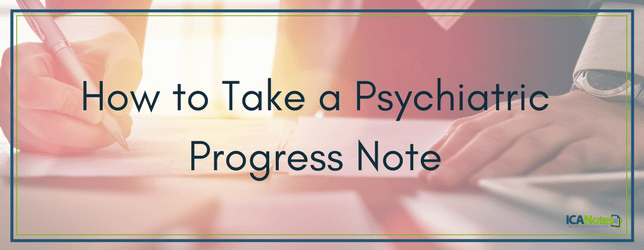How to Create an Effective Psychiatric Progress Note
Well-written psychiatric progress notes are vital for tracking patient progress and your clinic’s success. To maximize their effectiveness, many modern clinics are embracing the use of EHRs, or Electronic Health Records, to significantly speed up the note-writing process.
At ICANotes, we have perfected a turnkey system for any behavioral health clinic, including valuable templates for client sessions. Our progress notes allow for quick review by any member of your staff and can reduce the documentation time required to only a few minutes.
To create a comprehensive, clinically robust progress note, we recommend including these essential elements:
1. Symptom Updates
Provide thorough coverage of your patient’s report on how their symptoms are responding to treatment. This allows all reviewing parties to observe the effectiveness of treatment options. Be open with all responses indicating current treatment is ineffective, and make sure to cover all aspects of their symptoms as they evolve through treatment. Physical symptoms and psychological symptoms may respond at different rates.
2. Content of Therapy
This can be a brief review of what is covered during an individual examination. Here you need to document the client’s current state of mental health, and it’s helpful to relate this from their point of view.
3. Therapeutic Interventions
In this section, you can go into detail as to the specific methods of treatment explored during your session. Provide your approach and methods for the patient to accomplish goals based on their updated symptoms.
4. Mental Status
In this section, thoroughly and objectively cover every aspect of your client’s current mental health. This will include all elements that are present and problematic as well as symptoms that aren’t present, which helps to create a framework for diagnosis. This can also include observations of your client’s physical and verbal actions and reactions that suggest conditions they aren’t currently verbalizing.
5. Diagnoses
Here, you will list one or more specific diagnoses currently applicable to the patient. This will be updated as needed throughout treatment.
6. Instructions, Recommendation and Plan
This final section of your psychiatric progress note will provide a summary of the diagnosis, short-term goals and plan for care. Your goals should have target dates included to construct a timeline for treatment, with notes regarding progress reached against current goals. It could also indicate a lack of progress that necessitates revisions to current target dates. This note will wrap up with a recap of the time spent during the session.
The ICANotes EHR assists in creating these notes in an easy-to-read format with minimal typing required, such as this sample. Our robust library of behavioral health content helps you quickly document the essentials, freeing up time spent during and between sessions, allowing you to focus more time on your client and your practice.
If you would like to learn more about the ways you can implement Electronic Health Records into your practice, you can try out ICANotes with our free trial or contact our team at 866-847-3590 today.
Related Posts:
How to Create a Group Therapy Note
How to Create a Psychotherapy Note
The 10 Essential Elements of Any Therapy Note
The Differences Between Psychotherapy Notes and Progress Notes

